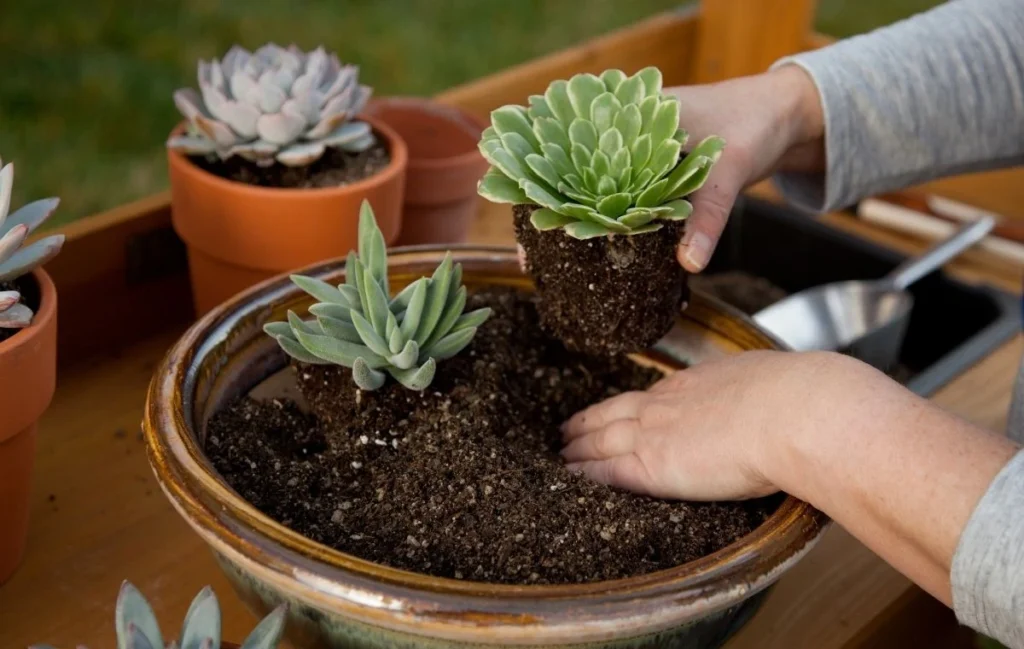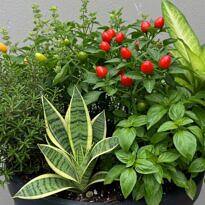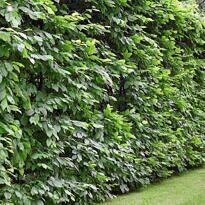Have you just received your first succulent? Or did you fall in love at first sight with these plants at the flower shop?
But now you don’t know how to take care of these fascinating, chubby, and geometric plants?
Welcome to the wonderful world of succulents, where, believe it or not, it’s harder to pronounce the complicated names of some species than to kill one of them. Have you tried saying “Echeveria elegans” without stumbling over the words? If yes, you’re on the right track to becoming a succulent master! And don’t worry… you won’t need to speak those complicated names.
But, if you’re wondering, “How can I take care of these little plants without killing them?”, then you’re in the right place.

Why succulents, you ask? Well, besides being nature’s answer for those who forget to water their plants, they are like little living trophies of survival. They thrive on neglect, grow where few plants dare to venture, and still grace us with a stunning variety of shapes, colors, and sizes. It’s as if nature said: “Here, have this nearly indestructible plant to make up for all those times you forgot to feed your goldfish.”
Now, before you rush to the nearest Garden Center or start filling your shopping cart with all the succulents you can find, let’s take a step back. Have you ever wondered why some succulents thrive and others… well, let’s just say they turn into a wilted salad? Is it just about throwing some water and hoping for the best? Or is there an ancient secret to the success of these hardy plants?
Get ready to embark on a delightful journey through the universe of succulents. This guide is not just a manual; it’s a passport to success in growing your own succulents, avoiding common pitfalls that make even the most promising gardeners give up.
So, are you ready to become the next succulent guru? Come on, grab your watering can (or maybe put it away, you’ll find out why) and get ready to dive into the fascinating world of “how to care for succulents”. Who knows, maybe by the end of this guide, you’ll be naming your succulents and talking to them like old friends. Don’t worry, I won’t judge you for it.
1. What are Succulents?
Have you ever wondered why succulents are called that? Is it because they regularly hit the gym to maintain that robust and healthy appearance? Or is it because they’re edible? Jokes aside, succulents are the kind of plant that even those who swear they don’t have a green thumb can take care of (and love). But before we dive into tips on how to care for these beautiful plants, let’s understand what they really are.
Succulents: The Camels of the Plant Kingdom
Imagine plants that store water in their leaves, stems, or roots, as if they were preparing their own reserve for a long journey through the desert. That’s the essence of succulents! They are the camels of the plant kingdom, adapted to survive in arid environments where water is a precious commodity that must be conserved. And it’s not just in the leaves that succulents can store water and nutrients reserves.
To be considered a succulent, a plant must have a water storage organ, which can be a stem, leaves, or even roots. Desert roses, for example, from the genus Adenium, are considered succulents because they store water in a special stem called a caudex, which becomes chubby and sculptural, although their leaves are not succulent.

So don’t be fooled, despite their resilience, they can be as delicate, different, and stylish as any other ornamental plant.
Main Characteristics:
Most succulents are known for their thick, fleshy leaves, a feature that helps them retain water. But did you know that not all succulents are the same? Some have rosette-shaped leaves, others look like small stones camouflaged in the soil, and there are those that extend as beautiful hanging plants. The diversity is so great that it’s practically impossible not to find one that captures your heart.
Main Groups and Examples:
Many plant families have succulent representatives. Some of them are entirely made up of succulent species. To give you an idea of the variety, let’s mention some of the main types of succulents:

- Cactaceae (Cacti): Yes, all cacti are succulents, but not all succulents are cacti. All cacti are succulents specialized in storing water, allowing them to thrive in extremely arid conditions. They are famous for their ability to withstand long periods without rain.
- Crassulaceae: Here we find the famous Echeveria, which looks like a stone rose, and the Sedum, perfect for those who forget to water their plants (who hasn’t?).
- Aizoaceae: Ever heard of Lithops, also known as living stones? They are so good at camouflaging that you might even mistake them for decorative pebbles.
- Euphorbiaceae: Although not all species in this family are succulents, many adopt chubby and spiny forms, similar to cacti, like the candelabra tree. However, be careful: many Euphorbiaceae are toxic and should be handled with caution.
- Asparagaceae: This family includes the popular Sansevieria, also known as snake plant, and the beautiful Agaves, renowned for their resilience. Their stiff, pointed leaves, and striking patterns make them favorites among many succulent enthusiasts.
- Asteraceae: Surprisingly, this large family of flowering plants, such as daisies and chrysanthemums, also has its succulent representatives, like the genus Senecio, with species ranging from hanging forms to shrubby ones, all adapted to store water.
- Apocynaceae: Includes some notable succulents, such as those from the genus Adenium and Pachypodium, both known for their swollen stems and beautiful flowers. They uniquely combine succulent aesthetics with showy blooms.
- Asphodelaceae: Family of the well-known Aloe, as well as other succulents like Haworthia and Gasteria. These plants are valued both for their medicinal properties and for their beauty and ease of cultivation.
So, which of these types of succulents has already won your heart? Or are you like me, finding it impossible to choose just one favorite?
So, Why Are Succulents So Popular?
Of course, they are beautiful and unique! But it’s not just about their singular appearance or the ease of care. Succulents bring a bit of nature indoors, creating a more cheerful and relaxing environment. Moreover, they are a great way to get started in the world of landscaping, even for those who think they don’t have the slightest knack for gardening.
Ready to delve into the fascinating world of succulents and discover how to care for them so they flourish and prosper in your home? Stay with us, and let’s unveil all the secrets of these incredibly rustic and, of course, charming plants!
2. How to Care for Succulents
Now that you know who’s who in the world of succulents, you’re ready to move on to the next step. Caring for succulents may seem like an intriguing challenge. However, with a few essential tips and a bit of attention to detail, you can transform your home into an oasis for these beautiful plants.

Basic Requirements
- Sunlight: Light is crucial for the health of succulents, providing the necessary energy for photosynthesis (feeding these little plants). Most succulents prefer direct and bright sunlight for 4 hours or more. A balcony or a spot near an east, north, or west-facing window is ideal, where sunlight is abundant at some point of the day, or all day long. But be careful: not all succulents like so much light, and it’s good to get used to identifying them and checking if they like direct sun or prefer more filtered light. Placing a shade-loving succulent in the sun is a recipe for sunburn on the leaves. Noticing your plant’s light needs can be a bit like interpreting signs, but with observation, you’ll find the perfect spot.
- Watering: The balance in watering is crucial. The method of “watering deeply, but infrequently” is most recommended. This means waiting until the soil is completely dry before watering again. And be generous with your plants each time you water, soaking the soil from the top until it drains through the drainage holes. The frequency of watering varies according to the climate and environmental conditions, but a good starting point is once a week. Always check if the pot feels light or if the substrate is dry with your fingers. Remember, it’s easier to recover a succulent from drought than from excess water.
- Soil: Succulents require well-aerated and drainable soil to avoid root rot. A ready-made substrate for cacti and succulents, usually including coarse sand or perlite, is ideal and the safest and easiest option. This facilitates water drainage, preventing the soil from becoming waterlogged. Think of the substrate as your succulent’s home; it needs to be comfortable and suitable for its growth. In other words, no standing water. Succulents like a loose soil that allows their roots to breathe.
- Temperature and Climate: Did you know that most succulents come from Mexico or South Africa? Succulents are quite resilient and can tolerate a wide range of temperatures, but they prefer a milder climate. Yes, they withstand heat and many withstand cold (especially those from South Africa), but they thrive best at moderate temperatures. Furthermore, most succulents do not withstand frost and should be kept in environments where the temperature does not drop drastically. If you live in an area with cold winters, below 32°F (0°C), consider bringing your succulents indoors during this period.

Planting and Transplanting
Pot Selection: Pots with drainage holes are essential to prevent water accumulation. Ceramic or terracotta pots are particularly good because they allow the soil to breathe, but you can use any material, even those plastic pots, as long as they have good drainage. Always choose pots a bit larger than the previous one for planting. Succulents do not like too much spare space in the pot. Do not use saucers under succulent pots, as it’s the same as inviting water to pool there and promote root rot.
How to Plant Succulents: When planting, make sure the soil is dry. Carefully remove the succulent from the current pot, eliminate the excess old soil from the roots, and place it in the new pot with fresh substrate. This provides a healthy new start for the plant. If your pot is up to 1.3 gallons (5 liters) you don’t need to worry about drainage layers. A handful of irregular stones over the holes is enough to prevent substrate loss. Moreover, once the plant roots well, the roots themselves will keep everything in place. Be careful not to press the substrate too hard in the pot, to avoid compacting it. Press gently just to firm your plant in place.
When and How to Transplant: Succulents generally need to be transplanted when they start to outgrow their pot, which can be noticed by excessive growth or roots appearing through the bottom of the pot. Choose a slightly larger pot and repeat the planting process, taking care not to damage the roots.
Consider Beheading: Don’t be scared! Beheading succulents is an intermediate to advanced technique that rejuvenates the plants and also allows their propagation. Use this technique, which removes the tip of the plant’s rosette, when your succulents are leggy, with few leaves below, or when they are affected by root problems. Read more about this technique in the article on beheading succulents.

Nutrition and Fertilization
Types of Fertilizers: Although succulents are not demanding regarding fertilization, a balanced fertilizer during the growing season can encourage more vibrant flowers and healthy growth. Use a balanced fertilizer with a slow-release formulation, like the cote type fertilizers (Osmocote or Basacote). Another option is to use fertilizers specifically for cacti and succulents, which are very mild and more complete, including the micronutrients they need in just the right measure.
When it comes to fertilization, remember that less is more. These plants originate from places with very little organic matter and low natural fertility, so the majority are quite efficient at utilizing available nutrients and prefer poorer soils.
Stay away from organic fertilizers when thinking about succulents. Worm castings, castor bean meal, or manures might seem like a good idea at first, but in the long run, they reduce the substrate’s aeration capacity, decreasing its porosity, and run the risk of rotting and attracting pests and diseases.
Fertilization Frequency: As a rule, fertilization should be limited to spring and summer, every four to six weeks, while your plant is growing or flowering. Avoid fertilizing in winter, when many succulents are in a state of dormancy. Fertilizing during this phase, besides being harmful, is a waste, since the plants will not be able to absorb the nutrients made available.
With these guidelines, caring for succulents becomes less of a mystery and more a rewarding journey of discoveries and successful cultivation. Keeping these basic principles in mind, you will be well-equipped to provide a perfect environment for your succulents, celebrating the beauty and diversity of these amazing plants.
3. Propagation of Succulents
Ah, the propagation of succulents! That magical moment when you become not just a gardener, but a true plant creator. Because, let’s be honest, seeing new life sprout from a simple leaf is a true miracle of nature, isn’t it? And the best part? It’s surprisingly easy!
Leaf Propagation
Have you ever looked at a succulent leaf and thought: “What if…?” Well, chances are, yes, it can turn into a new plant! All you need is a healthy leaf that has gracefully fallen or was removed with a gentle touch. Place it on succulent soil and wait. Yes, it’s a patience test, but who knows what that little leaf is scheming above the soil, right?
And you read it right. You don’t have to water, you don’t have to fertilize, you don’t have to do anything…
Succulents can sprout new plants just with the water reserve inside that little leaf. As soon as it starts to grow its first roots, then you can spray a little water to encourage rooting. And keep an eye out. From the base of the leaf, tiny new rosettes will emerge that can later be relocated and planted in an individualized pot.
Propagation by Cuttings (beheading):
Now, if you’re more of the type who likes a direct approach, propagation by cutting is for you. Moreover, many species prefer this method of propagation. Cut the top or a lateral branch of your succulent (with its permission, of course) and let the cut part heal for a few days. Then, just plant it in a slightly moist substrate and wait for the magic to happen. Simple, isn’t it?
Through these first two methods, many nurseries produce those small seedlings suitable for souvenirs, which are so successful out there. Have you ever thought about starting a business with your new talent for multiplying succulents?

Propagation by Seed:
For the brave, advanced, and patient, seed propagation might be the adventure you were looking for. It’s a bit like playing the lottery, but the feeling of seeing those very first tiny seeds germinating is indescribable. Get ready for a patience test, as it can take from a few weeks to several months. But the reward is worth the wait!
Collect seeds from ripe fruits. Many give the tip, opening by themselves to release the seeds. Place a bit of substrate suitable for germination in a transparent plastic pot (even a PET bottle or an ice cream container works), spread the tiny seeds over the substrate, moisten lightly with a sprayer (don’t soak!) and cover the pot. Place it in a location with indirect light. Monitor the evolution of your seedbed every 15 days, renewing the moisture if necessary.
And there you have it, fellow gardeners, the magic of succulent propagation. Whether by leaf, cutting, or seed, each method has its own charm (and challenges). But remember, in the world of gardening, every failure is just a step in your learning. Or, at the very least, a fun story to tell.
Ready to start your own propagation operation? Grab your gardening tools, and let’s bring new succulents to life!
4. Advanced Tips for Growing Succulents
Want to up your game in the world of succulents and leave all your friends amazed with your gardening skills? Maybe even turn your new hobby into a profitable business? Then, you’re in the right place! Let’s dive into some succulent landscaping techniques, create jaw-dropping compositions, and take a sneak peek at how to care for rare succulents. Oh, and for DIY fans, we have some incredible ideas for souvenirs and mini gardens. Ready? Then, take a deep breath, and let’s go!
Succulent Landscaping Techniques

Ever wondered how to turn that forgotten corner of the garden into a succulent oasis? Succulents are the artists of resilience and beauty. They don’t ask for much, just a bit of sunshine, little water, and lots of admiration. Use different heights, textures, and colors to create a dynamic visual effect. Try grouping low-growing succulents, like Sedum, with taller and more striking species, such as Echeveria gibbiflora, and finally different types of columnar cacti.
Who would have thought that combining the short with the tall would make a perfect pair, right? Place the taller plants in the back to frame the scene, and keep planting the shorter ones in layers until you finish with a beautiful ground cover of pebbles. And there you have your sustainable garden, with desert inspiration, that saves water, attracts admiring glances, and was made by you!
How to Create Attractive Compositions
Beauty is in the details. Mixing succulents with different shapes, textures, and colors can turn a simple pot into a living work of art. Ever thought about pairing a blue-green Echeveria with a dark-red Sedum? And don’t forget to play with the composition of the pots. A vintage pot or an old tea cup can be the perfect stage for your new succulent composition. Just don’t forget to make drainage holes if they don’t exist.
Tips for Growing Rare Succulents
Rare succulents are like celebrities among collectors. Want to be the privileged one to grow them? First, remember that they might need a bit more care. Before expanding your collection and acquiring more rare (and expensive!) plants, research their specific needs for light, substrate, and water. It’s best to gain a bit more experience with more common succulents first. To buy these beauties, visit specialized (and reliable) succulent sales websites, attend plant exhibitions and fairs in your city. And, like any good celebrity bodyguard, keep an eye out for pests and diseases. Creating a stable environment is key; replicate as faithfully as possible the habitat of these unusual plants. Think of it as preparing the dressing room for the star of the show.
How to Work with Souvenir Production

Looking for a hobby that can turn into a small business? Why not start creating succulent souvenirs? They are perfect for weddings, baby showers, or any event that deserves a touch of green. It’s simple: choose small pots or recycled containers, plant small succulent seedlings, and voilà! You have a living souvenir that your guests can enjoy for a long time. Who knows, you might become the official green supplier for all your friends’ events?
Remember that care matters a lot in this type of business, and pay attention to all the details. From the beauty and health of the plants, through the presentation of the pots, including quality and personalized labels, to impeccable service. This is the recipe for a business that thrives and attracts many customers through word of mouth. Don’t forget to price fairly, compensating for all your work, including the time you spent preparing each batch of souvenirs.
How to Set Up Mini Gardens in Pots
And for those who love a weekend project, how about setting up a mini succulent garden? Choose a wide pot and imagine it as your little blank canvas. You can create scenarios, like a miniature desert or a rocky garden. Set up the pot in the same way as planting, and accommodate the succulents creating compositions like streets, trees, flowers, a country house, a beach, a staircase, and whatever else your imagination calls for. Succulents are the stars, but feel free to add stones, colored sand, shells, dry branches, or miniatures to give that special touch. Break away from the usual and create hills and other levels in your mini garden, maybe making a mini mountain or a rocky valley.
So, what do you think? Ready to dive headfirst into the fascinating universe of succulents and leave your green mark on the world? Remember, the journey with succulent plants is full of experimentation, fun, and sometimes, a few lost leaves along the way. But, with these tips, you are more than prepared to make your succulents shine. Let’s go!?

Frequently Asked Questions
1. How often should I water my succulents to prevent them from rotting or shriveling?
Watering succulents is more of an art than a science. Generally, allow the soil to dry out completely between waterings. Depending on the climate, this may mean watering once a week or every two weeks. If your succulents start to look overly wrinkled, it might be past time to give them a drink. Avoid just dampening the soil slightly. Water enough so that it drains generously through the drainage holes, then allow the pot to dry out completely before watering again.
2. My succulent needs sunlight, but how much is too much? Will it get a tan?
Succulents love sunlight but are not fans of sunburn. Most prefer the morning or late afternoon sun, which is considered partial shade, but many can adapt to full sun in cooler temperatures. Plants under too much sun can acquire beautiful colored tones, but this indicates they are somewhat stressed. If your plant has dry, discolored spots on its leaves or stems, it’s probably getting too much light and suffering from burns.
3. Is the soil in my garden suitable for planting succulents, or do I need something more special, like a red carpet?
Succulents prefer loose, well-draining, and airy substrates. Don’t take a risk and use specific substrates for cacti and succulents, which include sand or perlite. The soil in your garden may be too dense and compact for them, with poor drainage, leaving them stuck in mud. If you want to landscape directly in the garden, add a good layer of sand, mixing well to incorporate, and elevate the beds to facilitate drainage.
4. What’s the best pot for my succulent, ceramic or plastic? Style or functionality?
It’s best to choose ceramic or terracotta pots with drainage holes. They’re like breathable clothing for roots, preventing excess moisture. Plastic can work, but sometimes retains too much water, which is not ideal. It’s worth experimenting, as it might work for you. A style tip is to mix pots of different shapes but the same color. Or two different patterns of color and texture. If you’re going for plastic pots, avoid black ones; they may work for marketing, but heat up too much.
5. Why are my succulents stretching out as if they’re searching for something lost?
This is called etiolation; it happens when they don’t get enough light and start stretching towards the sun. They lose their characteristic rosette shape, their colors become pale, and the stem can be seen between leaves. It’s as if they’re trying to catch the neighbor’s wifi. Give them more light, but gradually, over a few weeks, to avoid burning them. They need time to produce the necessary sun protection.
6. How can I propagate succulents without feeling like I’m performing delicate surgery?
Propagating succulents is surprisingly easy. Just take a healthy leaf, place it on soil for succulents, and wait. With patience, you’ll see small roots and eventually a new plant emerge. Often, we can use leaves that have been accidentally knocked off. They detach easily. Remember, patience is key; no advanced technique is needed to multiply them.
7. What if I accidentally break a part of my succulent, does it have life insurance?
Don’t worry, even though they may break from a fall or bump, succulents are quite resilient. Often, broken parts can be used to propagate new plants. It’s as if they have their own regeneration system. Prevent falls by using terracotta pots, which are heavier than plastic pots.
8. How do I deal with pests?
Combating pests in succulents doesn’t require advanced skills, but vigilance and early intervention. With them, it’s easy to be “too late,” so it’s important to keep an eye out. Isopropyl alcohol or insecticidal soap can be your allies in the fight against invaders like aphids and scale insects. Attack quickly and precisely to keep your plants healthy. If you notice rotting or softening parts of the plant, stop watering immediately and consider beheading.
9. Can my succulent survive the winter, or should I prepare a shelter for it?
Many succulents are sensitive to cold and need to be brought indoors or to a protected environment during the winter, especially if frosts occur in your region. Check the cold tolerance of your species, but generally, keep them away from freezing temperatures. When in doubt, bring your pots inside, near a well-lit window for them to spend the winter safely.
10. Can I leave my succulents in the rain?
Leaving your succulents in the rain isn’t a problem, but caution is needed. Although an occasional downpour can help wash off dust from the leaves and knock down pests, too much water can lead to root rot. So, if you live in an area with long, relentless rainy periods, it’s better to keep them under cover. Think of it as offering them an umbrella; they appreciate the water but prefer not to get soaked. Additionally, pay even more attention to the drainage of pots and substrates, avoiding the chance of your plants getting waterlogged.








